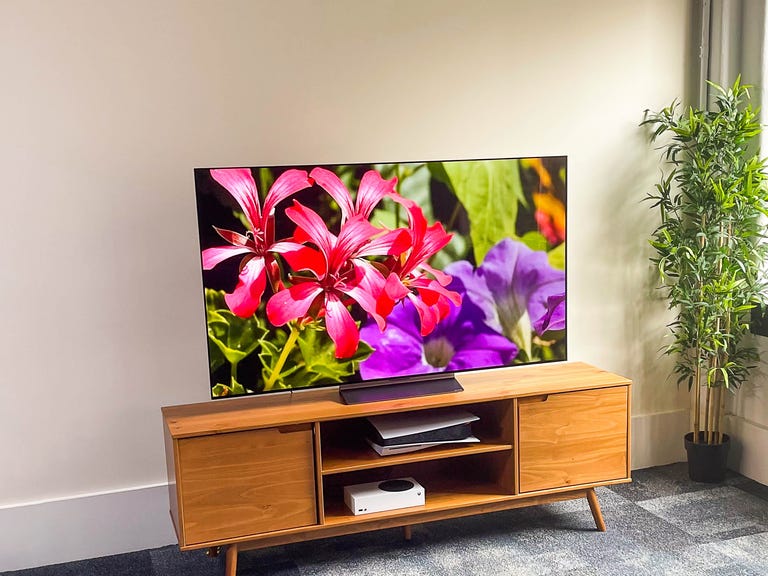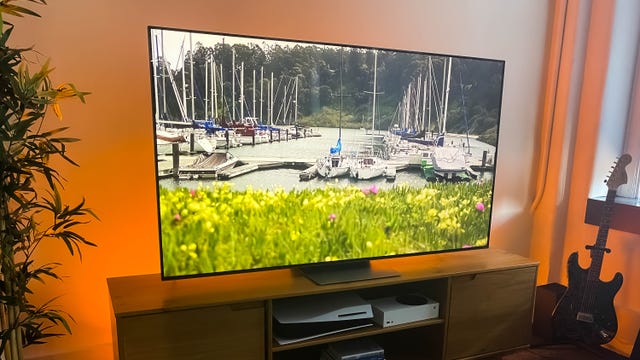
<div content="LIST ITEM" superlative="Second-best value gaming TV" description="
In our review of the Hisense we rated its overall image quality nearly as good as the TCL, and we actually liked its gaming picture a bit better, thanks to punchier highlights. It comes in second to the TCL with worse lag, but most people won’t notice the extra 5 milliseconds. Gamers can’t go wrong with either one.
Its excellent image quality is anchored by best-in-class brightness that improves its bright-room picture quality and makes HDR TV movies, shows and games really pop. It’s actually brighter than the TCL with better contrast, but the TCL’s slightly more accurate image gave it the edge overall. The Hisense uses Google TV instead of Roku, and unlike the TCL, the U8H includes an ATSC 3.0 tuner. Frankly, you can’t go wrong with either one.
Pros:
- Relatively affordable
- Excellent overall image quality
- Best-in-class bright room picture
- Capable Google TV system
Cons:
- Slightly less refined image than some competitors
- "Theater" picture modes engage motion smoothing by default
This is a 2022 model, but the 2023 version, the U8K series, looks largely similar aside from the addition of a 75-inch option. We haven’t reviewed it yet. It’s currently a couple of hundred dollars more expensive than the U8H.
” page-position linktext=”Read our Hisense U8H series review” linkurl=”https://www.cnet.com/tech/home-entertainment/hisense-u8h-google-tv-review-bright-powerful-and-affordable/” can-collapse=”true” collapse-on-page-load=”true” can-truncate=”true” truncate-on-page-load=”true” offer=”{"id":"ccf035f9-9108-4542-a617-b55bbf60401b","label":"Hisense 65U8H","slug":"hisense-65u8h","edition":["US","ES"],"imageId":"93fb7373-4400-47ba-ac1b-7df8cba38c52","imgUrl":"/content/image/redirect/93fb7373-4400-47ba-ac1b-7df8cba38c52/resize/75×56","typeLabel":"Tech Product","objectType":"content_product","icon":"type-icon ct-cmg-tech-product ct-small"}” techobjectinfo=”{"uuid":"ccf035f9-9108-4542-a617-b55bbf60401b","slug":"hisense-65u8h","name":"Hisense 65U8H","productType":"PRODUCT","updateType":"PRISM","mod":1703660303378}” overridecredit=”David Katzmaier/CNET” overridecaption=”” imagegroup=”{"uuid":"96bb8cfe-c76e-4753-8857-01f2b395f06b","alt":"Hisense U8H 2022 Google TV","caption":"","credits":"David Katzmaier","imageData":{"id":"96bb8cfe-c76e-4753-8857-01f2b395f06b","filename":"hisense-u8h-2022-google-tv-6455.jpg","path":"https://www.cnet.com/a/img/resize/a34f26e5ab3e2a9dda771a4d6f917faf3d2f377b/hub/2022/10/31/96bb8cfe-c76e-4753-8857-01f2b395f06b/hisense-u8h-2022-google-tv-6455.jpg?auto=webp&height=500","dateCreated":{"date":"2022-10-31 21:41:00.000000","timezone":"UTC","timezone_type":3},"primeColor":null,"hasWarning":false},"size":"","float":"","lightbox":false,"imageUrl":"https://www.cnet.com/a/img/resize/a34f26e5ab3e2a9dda771a4d6f917faf3d2f377b/hub/2022/10/31/96bb8cfe-c76e-4753-8857-01f2b395f06b/hisense-u8h-2022-google-tv-6455.jpg?auto=webp&height=500","imageCaption":"","imageCredit":"David Katzmaier","imageAltText":"Hisense U8H 2022 Google TV","imageFilename":"hisense-u8h-2022-google-tv-6455.jpg","imageWidth":3805,"imageHeight":2140,"imageDoNotCrop":false,"imageDoNotResize":false,"imageWatermark":false,"imageDateCreated":"2022-10-31","imageParallax":"","imageCrop":"","imageEnlarge":false}” usepricing=”true” ng-block=”{"id":"zjepqxj793359g9","type":"listicle"}” edition=”us” data-key=”cnetlisticle__7d4e81d1-8b66-4ba4-bc30-34de55ac4bb5″ index=”3″ imagecredit=”David Katzmaier/CNET” tagslugs=”hv28,4k-tvs,amazon,lg,microsoft,samsung,sony,vizio,tcl” contenttype=”Best List – Precap” isbestlistredesign=”true” filtershortcodetypes totalfilteritems=”0″ pagelayout=”Default – Article Page” showdetails=”true” tocheadlineitem=”[object Object]” class=”c-bestListProductListing” readability=”5.8630999213218″>
Photo Gallery 1/1
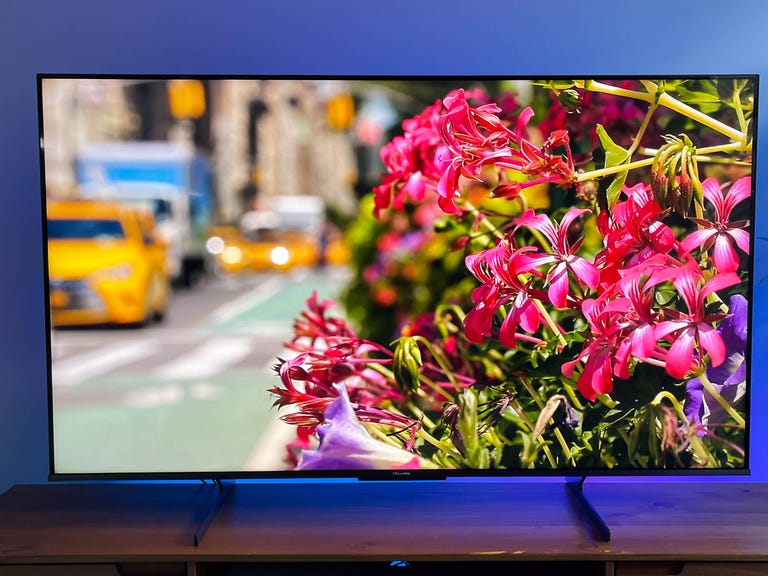
Show expert take Show less
The Vizio V-Series costs hundreds less than any of the TVs above, its image quality can’t compete, and it lacks 4K, 120Hz input, but for a budget model its gaming chops are top-notch. It’s the only budget TV we’ve seen that supports variable refresh rate, and its overall image quality was a cut above similarly priced models from TCL, Hisense and others.
Pros:
- Solid image quality for en entry-level TV
- Lots of features including VRR and Wi-Fi 6E
Cons:
- Poor built-in smart TV system
The price shown below is for the 65-inch size.
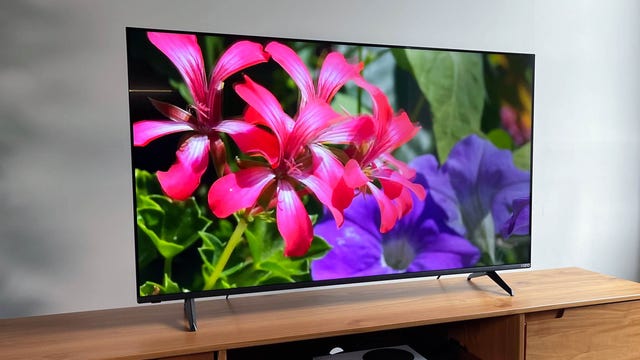
<div content="LIST ITEM" superlative="Affordable option with 4K 120Hz and VRR" description="
With a price generally lower than any of the TVs above, this Vizio’s image quality and gaming features aren’t quite as good, but it’s still a solid step above budget gaming TVs. Local dimming achieves solid contrast and the MQX has both 4K/120Hz input capability and VRR, which are rare at this price.
Pros:
- Affordable
- Excellent picture quality
- Game-friendly extras like variable refresh rate and 4K/120Hz input
Cons:
- Weak smart TV system
- Slightly more-expensive TVs perform better
Unlike the M7 from 2021, the MQX has a true 120Hz refresh rate, which allows compatibility with 4K/120Hz signals from game consoles like the Xbox Series X and PlayStation 5, and it worked well in our tests. Vizio supports both major HDR formats, HDR10 and Dolby Vision, in the M-Series. If you can’t save up for the TCL or the Hisense but want a better picture than the TCL 4-Series or Vizio V-series, the Vizio MQX is an excellent happy medium.
Vizio hasn’t announced a 2023 version of this TV.
” page-position linktext=”Read the Vizio M-Series Quantum X review” linkurl=”https://www.cnet.com/tech/home-entertainment/vizio-m-series-quantum-x-review-bright-hdr-picture-made-affordable/” can-collapse=”true” collapse-on-page-load=”true” can-truncate=”true” truncate-on-page-load=”true” offer=”{"id":"e1be970d-e85e-4723-868d-e36426621b61","label":"Vizio M-Series Quantum X (2022)","slug":"vizio-m-series-quantum-x-2022","edition":["US","ES"],"imageId":"2348331e-2422-4844-b53b-8bcd505eabac","imgUrl":"/content/image/redirect/2348331e-2422-4844-b53b-8bcd505eabac/resize/75×56","typeLabel":"Series","objectType":"content_product_series","icon":"type-icon ct-cmg-tech-product-series ct-small"}” techobjectinfo=”{"uuid":"e1be970d-e85e-4723-868d-e36426621b61","slug":"vizio-m-series-quantum-x-2022","name":"Vizio M-Series Quantum X (2022)","productType":"SERIES","updateType":"PRISM","mod":1703660303596}” overridecredit=”David Katzmaier/CNET” overridecaption=”” imagegroup=”{"uuid":"d0995e0f-fbb4-4bb0-8798-b299177f0588","alt":"Vizio MQX Series 2022 TV","caption":"","credits":"David Katzmaier","imageData":{"id":"d0995e0f-fbb4-4bb0-8798-b299177f0588","filename":"vizio-mqx-series-2022-5957.jpg","path":"https://www.cnet.com/a/img/resize/3ba30a4c1e1501b00f5568b0760852283a2bb18b/hub/2022/08/26/d0995e0f-fbb4-4bb0-8798-b299177f0588/vizio-mqx-series-2022-5957.jpg?auto=webp&height=500","dateCreated":{"date":"2022-08-26 15:48:54.000000","timezone":"UTC","timezone_type":3},"primeColor":null,"hasWarning":false},"size":"","float":"","lightbox":false,"imageUrl":"https://www.cnet.com/a/img/resize/3ba30a4c1e1501b00f5568b0760852283a2bb18b/hub/2022/08/26/d0995e0f-fbb4-4bb0-8798-b299177f0588/vizio-mqx-series-2022-5957.jpg?auto=webp&height=500","imageCaption":"","imageCredit":"David Katzmaier","imageAltText":"Vizio MQX Series 2022 TV","imageFilename":"vizio-mqx-series-2022-5957.jpg","imageWidth":3000,"imageHeight":2143,"imageDoNotCrop":false,"imageDoNotResize":false,"imageWatermark":false,"imageDateCreated":"2022-08-26","imageParallax":"","imageCrop":"","imageEnlarge":false}” usepricing=”true” ng-block=”{"id":"ot3cfg9164qh91m","type":"listicle"}” edition=”us” data-key=”cnetlisticle__e398ee72-6ef3-44e2-b12b-bac298a57a72″ index=”5″ imagecredit=”David Katzmaier/CNET” tagslugs=”hv28,4k-tvs,amazon,lg,microsoft,samsung,sony,vizio,tcl” contenttype=”Best List – Precap” isbestlistredesign=”true” filtershortcodetypes totalfilteritems=”0″ pagelayout=”Default – Article Page” showdetails=”true” tocheadlineitem=”[object Object]” class=”c-bestListProductListing” readability=”5.4555984555985″>
Photo Gallery 1/1
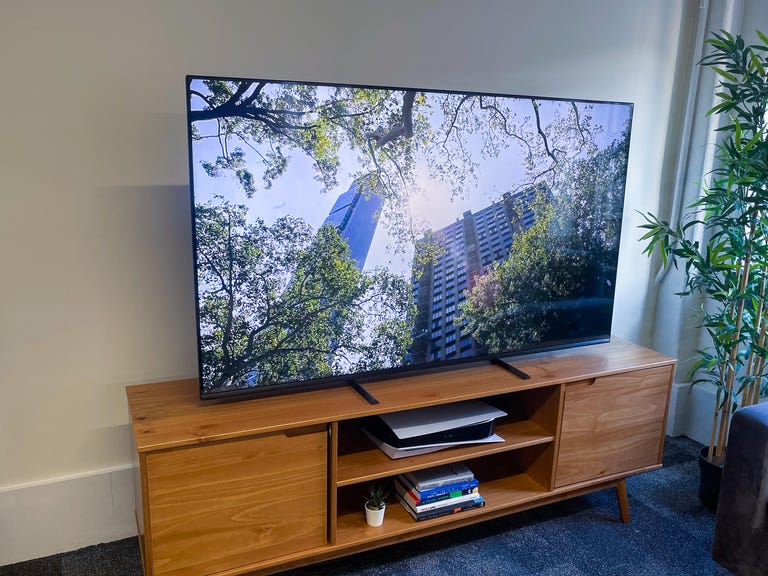
Show expert take Show less
Check out How We Test TVs for more details.



